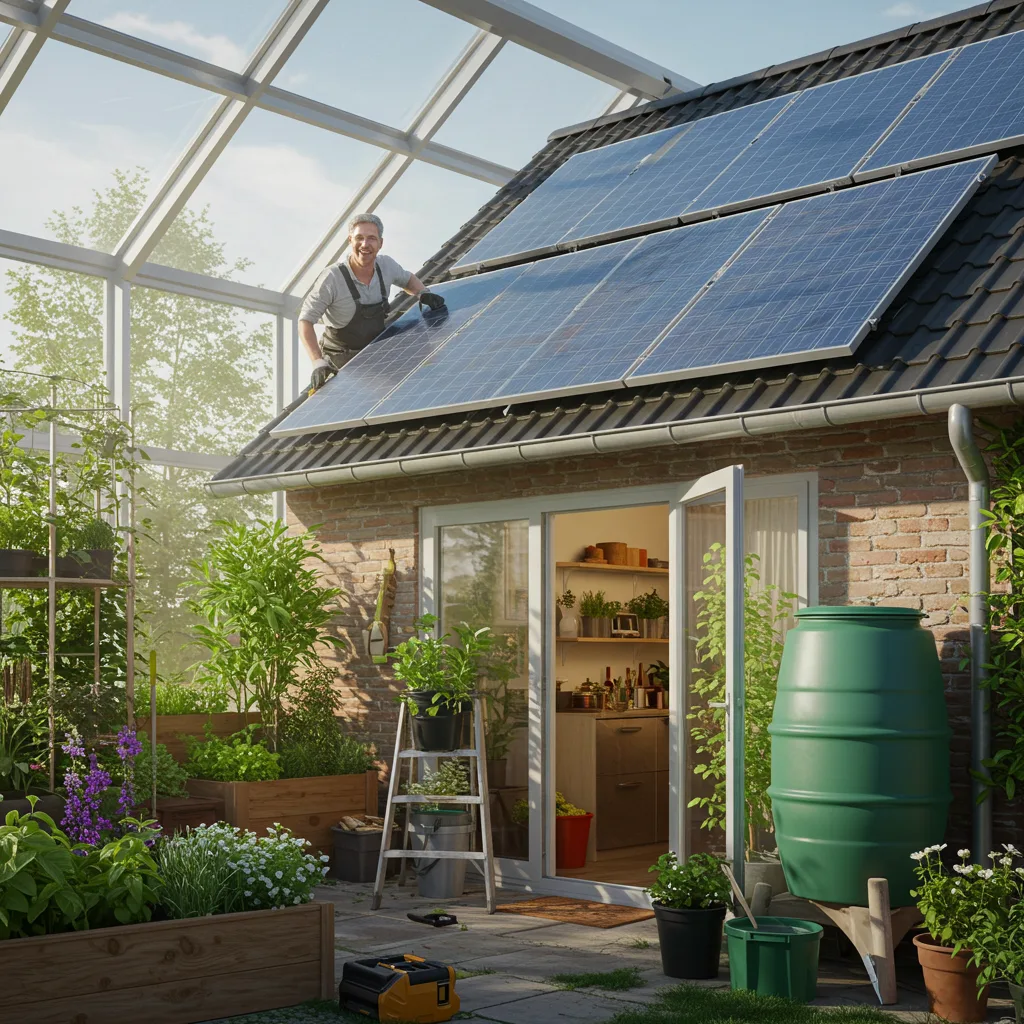DIY Eco-Friendly Home Upgrades with Green Energy and Water Conservation for 2025
DIY eco-friendly home upgrades are gaining traction in the USA for 2025, blending green energy and water conservation to cut costs and boost sustainability. With U.S. households spending $2,000 annually on energy and $1,000 on water, per the U.S. Energy Information Administration and EPA, these upgrades align with rising consumer demand for sustainable living. This guide, crafted for EcoDweller.com, offers actionable steps to transform your home, incorporating urban gardening, green investments, and zero waste solutions, while linking to trends like home electrification and eco-friendly car insurance.

Why DIY Eco-Friendly Upgrades Matter in 2025
Sustainability is a priority as energy costs rise 10% in 2024, per the NERC, and water scarcity affects 40% of U.S. regions, according to the NRDC. DIY upgrades save 20–40% compared to professionals, per the National Renewable Energy Laboratory, and support green home trends like electrification and ethical investments. These projects also reduce your carbon footprint, aligning with eco-friendly car insurance incentives.
Benefits of DIY Eco-Friendly Home Upgrades
- Cost Savings: Reduces energy and water bills by 20–40%.
- Green Energy Boost: Integrates solar panels and efficient systems.
- Water Conservation: Lowers usage with smart systems.
- Urban Gardening: Enhances indoor food production.
- Zero Waste: Minimizes household waste output.
Step-by-Step Guide to DIY Eco-Friendly Upgrades
Follow these steps to upgrade your home sustainably.
1. Assess Your Home’s Energy Needs
Use a $15 energy meter from Home Depot to track usage, per the Energy Saver. Aim for 5–10% reduction targets.
2. Install Solar Panels
Mount $200 DIY panels with a $50 inverter, guided by the NREL, for green energy savings.
3. Set Up a Rainwater Harvesting System
Add a $100 barrel and $20 gutters from Home Depot, per the EPA, to conserve water.
Tip: Check Local Codes
Verify permits with your city hall to ensure compliance.
4. Electrify Appliances
Switch to $300 electric models, per the Energy Saver, supporting home electrification trends.
5. Start Indoor Urban Gardening
Use a $50 LED grow light and $20 pots from Amazon, per the EPA, for fresh produce.
6. Reduce Waste with DIY Solutions
Build a $30 compost bin, per the USDA, to achieve zero waste goals.
7. Insulate Windows
Add $40 weather stripping from Home Depot, per the Energy Saver, to retain heat.
8. Explore Green Investments
Invest $500 in renewable energy stocks via Fidelity, per emerging 2025 trends, for long-term gains.
9. Switch to Eco-Friendly Car Insurance
Save 10% with green policies from GEICO, per EcoDweller’s guide.
10. Monitor and Maintain
Use a $20 app from Energy Monster to track efficiency, per the EPA.
Cost and Savings Comparison
| Upgrade | Cost (DIY) | Cost (Professional) | Annual Savings |
|---|---|---|---|
| Solar Panels | $250 | $1,000 | $300–$500 |
| Rainwater System | $120 | $400 | $100–$200 |
| Electric Appliances | $300 | $600 | $150–$300 |
Maintenance Tips for Your Upgrades
Clean solar panels monthly with water, per the NREL. Check water systems quarterly with a $10 tool from Home Depot. Monitor garden health with a $15 kit from the USDA.
Tip: Seasonal Checks
Inspect systems after weather changes to ensure efficiency.
Case Study: A Family’s Success
A Colorado family upgraded their home in 2024 with solar panels and a rainwater system for $370, saving $450 annually, per their EPA report. They added urban gardening in 2025, cutting grocery costs by 15%.
Challenges and Solutions
Challenges include initial costs and maintenance time, but online guides simplify the process. For instance, consulting Green Building Advisor resolves technical issues effectively.
Frequently Asked Questions
What’s the best DIY upgrade for beginners?
Start with window insulation, per EcoDweller’s guide.
How much can I save?
Savings range from $100–$500 yearly. See our cost table.
Is green investing safe?
Yes, with research via Fidelity, per 2025 trends.
Conclusion
DIY eco-friendly home upgrades with green energy and water conservation transform your home for 2025, saving money and embracing sustainability. From solar panels to urban gardening, these steps align with zero waste, home electrification, and green investment trends. Visit EcoDweller.com for more, including green home trends and eco-friendly car insurance guides. Ready to upgrade? Share your plans below!

